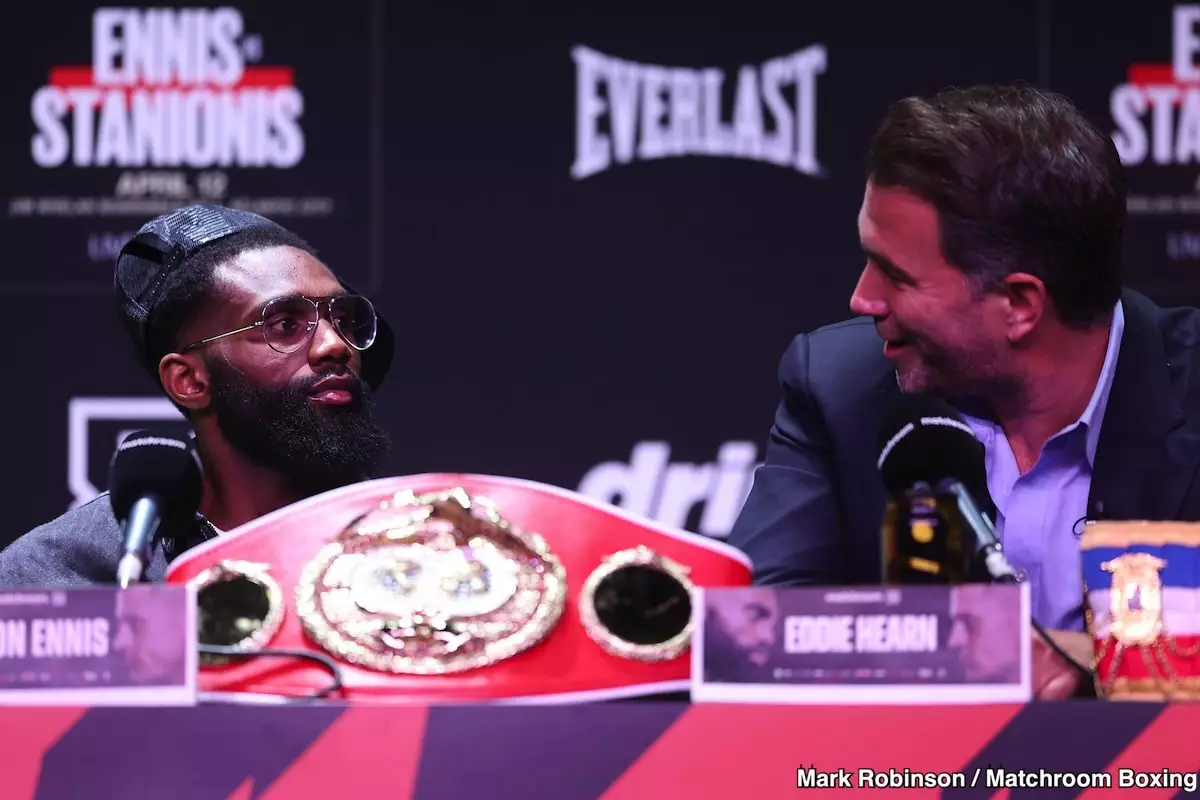Jaron ‘Boots’ Ennis is a name that echoes through the boxing world, particularly in the welterweight division where he stands triumphantly with an impressive record of 33 wins, 29 by knockout. However, his reputation has recently come under fire following an alleged refusal to face Vergil Ortiz Jr., another rising star who has quickly earned a reputation as a formidable opponent. Ennis claims the narrative that he has ducked a fight with Ortiz is rooted in misunderstanding and miscommunication, an assertion that deserves careful examination.
The backdrop of this controversy is the staggering pay that would accompany a clash with Ortiz—reported upwards of $8 million. Fans and analysts have speculated on why Ennis would take a arguably less lucrative fight against Eimantas Stanionis instead. After all, turning down such a significant payday in favor of another fighter is rare in today’s boxing climate, where financial incentives often drive decision-making. The initial reaction from the boxing community has been one of skepticism, branding Ennis’s actions as avoidance rather than strategy.
What’s Really at Stake?
In a sport defined by risk, where fighters put their physical and reputational well-being on the line, the question arises: is it possible that Ennis is genuinely looking to avoid facing Ortiz, widely viewed as a dangerous opponent? Analysis of Ennis’s stated desire to remain at welterweight suggests that a potentially fearsome battle with Ortiz could lead to a loss that tarnishes his pristine record. In these high-stakes encounters, every decision can have monumental implications, both financially and athletically.
From the perspective of talent evaluation, the match against Ortiz is not merely a chance to earn a fat paycheck. It represents a rite of passage for a champion. Engaging with an opponent like Ortiz, who is brimming with confidence and skill, could either solidify Ennis’s standing as a serious contender or irrevocably alter his career trajectory should he falter. The decision to fight Stanionis seems like a calculated maneuver—a fight that, while still challenging, arguably carries a lower risk and could keep his unbeaten record intact.
The Narrative Machine: Public Perception and Criticism
Ennis, refuting claims of ducking, points toward external miscommunications and insists the community mischaracterizes the situation. His frustration is palpable as he addresses the “podcasters and YouTubers” who speculate without a full understanding of the complexities involved in fight negotiations. This admission highlights a deeper issue within the boxing realm: the interactive media landscape often breeds narratives that can overshadow actual events.
Critics are inclined to label Ennis’s decision as evasive, but the nature of public perception in boxing often skews the truth. Boxers are subject to a media machine that spins tales around them, and as a result, athletes like Ennis can find themselves wrestling not only with opponents in the ring, but with their image in the eyes of the public. Is it fair or even accurate for fans and commentators to label a fighter like Ennis as ducking an opponent without fully understanding the dynamics at play?
Facing the Reality: Understanding Fighter Decisions
It is crucial to reconcile the fans’ expectations with the reality of the boxing profession. Fighters are not merely gladiators; they are strategic businesspeople navigating precarious waters. For every fight that takes place, countless negotiations, strategy sessions, and health assessments contribute to the final decision.
Understanding Ennis’s choice to prioritize Stanionis might eventually yield positive results for his career, securing his legacy without the immediate risk of defeat against Ortiz. This kind of strategic thinking reflects the complexities inherent to professional athletes—success does not come solely from strength and skill; it also requires astute navigation of opportunities and threats.
In light of these considerations, it’s worth acknowledging that while the boxing community thrives on narratives of bravery and valor, the decisions made by fighters are often underpinned by an intricate array of factors that transcend simple notions of courage. So, when Ennis insists he hasn’t ducked anyone, it surfaces deeper questions about how we perceive risk, opportunity, and the paths to success within combat sports. The narrative around his decision could end up influencing a significant chapter in the sport’s ongoing story, pointing towards a critical discussion about the intersection of media, perception, and athlete agency.


Leave a Reply